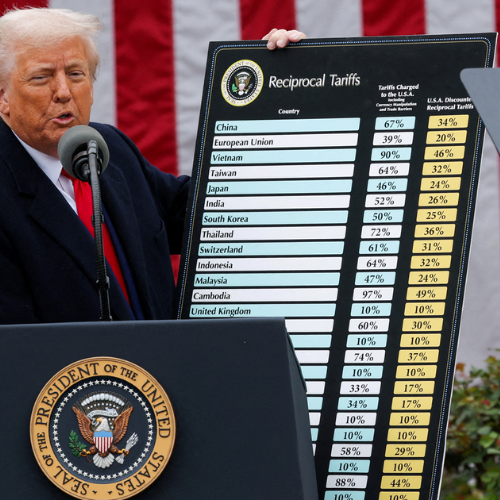On Wednesday, U.S. President Donald Trump announced a new wave of tariffs, targeting several nations with varying rates. These tariffs, known as “reciprocal tariffs,” are meant to counter what Trump calls unfair trade practices. He stated that the U.S. has been “looted, pillaged, raped, plundered” by other countries for years. The new tariffs start at a baseline of 10% but go as high as 49% for some nations.
The hardest-hit countries include Vietnam, Japan, South Korea, Taiwan, and Thailand, with tariffs ranging from 24% to 46%. China, the country with the largest trade surplus against the U.S., will face a 34% tariff. However, when combined with previous tariffs related to the fentanyl crisis, the total tariff rate on Chinese goods reaches 54%.
India will see a 26% tariff, while the European Union is subject to a 20% charge. The tariffs aim to balance trade and push other nations to reduce barriers against American products.
Nike and Adidas Struggle as US Tariffs Target Vietnam Production
Canada and Mexico Escape New Tariffs, but Not Trade Actions
Canada and Mexico, two of the U.S.’s largest trading partners, were relieved to find that they were not included in the new tariff wave. However, this does not mean they are entirely free from U.S. trade restrictions. Earlier this year, Trump had already placed 25% tariffs on imports from both countries, along with additional charges on Canadian energy and potash.
The White House clarified that the reason Canada and Mexico were excluded from the new tariffs is that they are already subject to strict duties. Goods coming into the U.S. under the US-Mexico-Canada Agreement (USMCA) remain tariff-free, but any items outside that agreement will still be subject to levies.
Despite avoiding the latest tariffs, both Canada and Mexico remain concerned. Canadian Prime Minister Mark Carney stated that his government would respond with counter-measures to protect its economy and workers. Meanwhile, Mexican President Claudia Sheinbaum is expected to announce Mexico’s response during a press conference on Thursday.
3 Asian Giants Japan, China and South Korea Unite Against US Tariffs, Pursue Bold Free Trade Pact
Russia and North Korea Left Out Due to Sanctions
Russia and North Korea were also notably absent from Trump’s tariff list. However, their exclusion does not indicate improved trade relations with the U.S. Instead, the White House explained that both countries, along with Cuba and Belarus, are already subject to heavy economic sanctions that effectively block trade with the U.S.
With these sanctions in place, imposing additional tariffs would have little impact since there is minimal trade occurring in the first place. The decision to exclude these countries aligns with existing U.S. policies that restrict their economic activities on a broader scale.
Trump’s latest tariffs have sent shockwaves through global markets. Countries facing the heaviest tariffs are expected to retaliate, which could lead to increased trade tensions. For now, nations like Canada and Mexico breathe a sigh of relief, but they remain wary of the long-term impact of U.S. trade policies.


